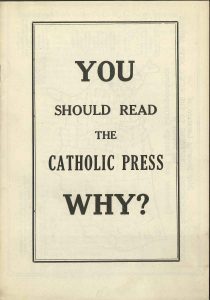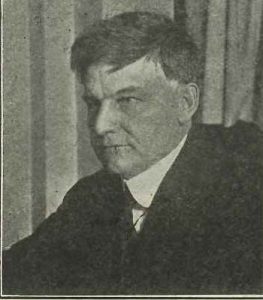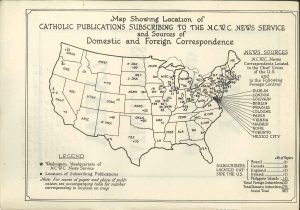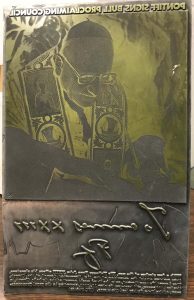
The first national Catholic press in the U.S. formed in 1911 with the Catholic Press Association. Its purpose was to stabilize advertising services and to start a national news service, which it did, called the News Bureau. By 1915 it was gathering news and developing newsletters from Rome, London and Washington, D.C. as a subscription based service for its member publications, which were primarily diocesan and independent Catholic newspapers in the U.S. In 1919, just after the formation of the National Catholic Welfare Council (NCWC), today known as the U.S. Conference of Catholic Bishops, the NCWC Press Department absorbed the function of the Catholic Press Association, stabilizing and promoting the dissemination of news of interest to Catholics nationally. Its aim was to publish news of national and international interest to Catholics in the United States—news that was often ignored in the mainstream press. Subscribers to the news service—local or special interest Catholic news outlets—would supplement their own content with the Press Department’s news, editorial features, and picture services in their own publications under the name NCWC News Service. The NCWC News Service changed its name in the 1960s to the National Catholic News Service or NC News, then again in 1986 to its current name, Catholic News Service (CNS) to reflect its mission to cover world news of relevance to Catholics.¹

This new national Catholic press focused on matters of interest to Catholics nationally, particularly those matters that the mainstream press ignored or reported from a non-Catholic and often anti-Catholic perspective. One 1922 NCWC News Sheet, for example, reported in October of that year that the Ku Klux Klan was asserting that “because Columbus was a Catholic,” Leif Ericson should be considered “the real discoverer of America.” The KKK’s view held that Columbus’s Catholicism disqualified him from a role in the history of European colonization, and that Leif Ericson’s Nordic background made him qualified for a special place in that history. The news sheet countered that in fact, Leif Ericson was a Catholic anyway so the KKK’s plan to dethrone Columbus based on religious grounds was futile—not an argument that would be seen in the mainstream press because the mainstream press freely expressed anti-Catholic sentiment as well. Other topics heavily covered by the Catholic press in these years concerned the persecution of priests and nuns in Mexico and the Spanish Civil War of 1936-1939. Church figures in the U.S. felt that the U.S. government was not doing enough to counter anti-Catholic violence in the 1920s Cristero War, and in contrast with many non-Catholic Americans, were more sympathetic to the pro-Catholic Franco regime in Spain than they were to the Soviet backed Popular Front.²

Additionally, the NCWC News Service covered the Catholic angle of topics popular in mainstream media as well. In 1944, for example, the News Service reported on Japanese Catholic internees and on the ways the U.S. liberation of Guam resulted in the reopening of one of the island’s Catholic churches. A March, 1959 news release reported on John F. Kennedy’s assertion that “there is no conflict between being a Catholic and meeting your constitutional obligations as an officeholder.”³

With a current incarnation that is more global in reach than ever, almost every English language Catholic newspaper in the world uses CNS, including more than 200 American Catholic newspapers and websites, radio, and video broadcasters as well as news broadcasters in more than 60 countries. As an editorially independent and financially-self-sustaining division of the U.S. Conference of Catholic Bishops, CNS has created several media outlets, including Origins, the documentary service created in 1971 that chronicles the history of the church through full texts of speeches, encyclicals, and other documents. It offers online book reviews, as well as movie, television, and gaming reviews from a Catholic perspective as well. Finally, CNS provides images and news graphics in digital and print format and produces daily video from Washington and Rome.⁴
To view our finding aid for the United States Conference of Catholic Bishops Communications department and Catholic News Service, see our finding aid: http://archives.lib.cua.edu/findingaid/ncnews.cfm
For more on local Catholic newspapers, see the Catholic News Archive: https://thecatholicnewsarchive.org/
¹ N.C.W.C. News Service press release, 10/30/1944, 3/5/1959, held at the USCCB archives which holds National Catholic Welfare Conference News Service/Catholic News Service archival records.
² See our finding aid: http://archives.lib.cua.edu/findingaid/ncnews.cfm
³ For a short history of Catholic News Service, see our finding aid to their papers here: http://archives.lib.cua.edu/findingaid/ncnews.cfm
⁴ See “The N.C.W.C. News Sheet,” releases: October 30, 1922, Benedict Elder, “Ku Klux Show Ignorance In Proposal to Substitute Ericson for Columbus”; December 12, 1927 “Priest Hanged, Nun Is Shot In Mexico, Letters Reveal,” held at the USCCB archives which holds National Catholic Welfare Conference News Service/Catholic News Service archival records.
